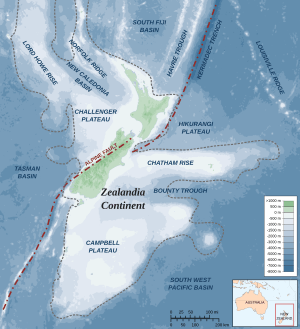Alpine fault facts for kids

The Alpine Fault is a very long crack in the Earth's crust. It runs all the way through New Zealand's South Island. This fault is like a giant seam where two huge pieces of the Earth's surface meet. These pieces are called the Pacific Plate and the Indo-Australian Plate. When these plates slowly move past each other, they can cause powerful earthquakes. Over millions of years, these earthquakes have helped create the tall Southern Alps mountains.
Contents
What is a Fault?
A fault is a break in the Earth's crust. Think of the Earth's surface as a giant jigsaw puzzle made of many pieces called tectonic plates. These plates are always moving, but very slowly, like fingernails growing. When two plates meet, they can slide past each other, crash into each other, or pull apart. A fault is where this movement happens.
Where is the Alpine Fault?
The Alpine Fault stretches for about 600 kilometers (370 miles) along the western side of the South Island. It goes from near Milford Sound in the southwest all the way up to the Marlborough region in the northeast. It's one of the most active and well-known faults in the world.
Two Plates Meet
The Alpine Fault marks the boundary between two major tectonic plates:
- The Pacific Plate is on the southeastern side of the fault.
- The Indo-Australian Plate is on the northwestern side.
These two plates are constantly grinding past each other. This type of movement, where plates slide horizontally, is called a strike-slip motion. However, at the Alpine Fault, the Pacific Plate is also pushing slightly upwards over the Indo-Australian Plate. This combination of sliding and pushing is what helps build the mountains.
How the Southern Alps Formed
The Southern Alps are a stunning mountain range that runs along the South Island. They are a direct result of the Alpine Fault's activity. As the Pacific Plate pushes against and slides past the Indo-Australian Plate, the land is squeezed and lifted upwards. Imagine pushing two rugs together; they would wrinkle and rise in the middle. This slow, powerful process, happening over millions of years, has created the towering peaks we see today.
Earthquakes and the Fault
The movement along the Alpine Fault doesn't happen smoothly all the time. Instead, stress builds up as the plates try to move but get stuck. When the stress becomes too great, the fault suddenly slips, releasing a lot of energy. This sudden release of energy is what we feel as an earthquake.
Scientists study the Alpine Fault closely because it has a history of producing very large earthquakes, often around magnitude 8. These big quakes happen roughly every 200 to 300 years. The last major earthquake on the Alpine Fault was in 1717.
Why is the Alpine Fault Important?
The Alpine Fault is important for several reasons:
- Natural Laboratory: It's a fantastic place for scientists to study how large faults work and how mountains are built.
- Earthquake Risk: Because it's so active and can produce big earthquakes, understanding the Alpine Fault helps New Zealand prepare for future events.
- Landscape Creator: It has shaped the unique and beautiful landscape of the South Island, including the Southern Alps and many valleys.
Scientists use special tools to monitor the fault's movement. They also look at the history of past earthquakes by studying the ground and rocks. This helps them understand the fault's behavior and predict when the next big earthquake might happen, though predicting the exact time is still not possible.
Images for kids




